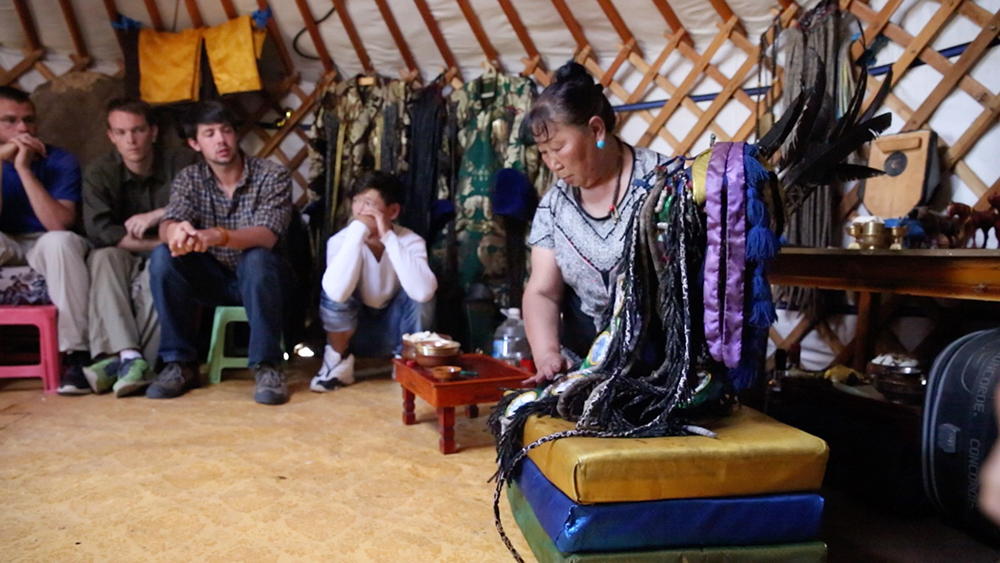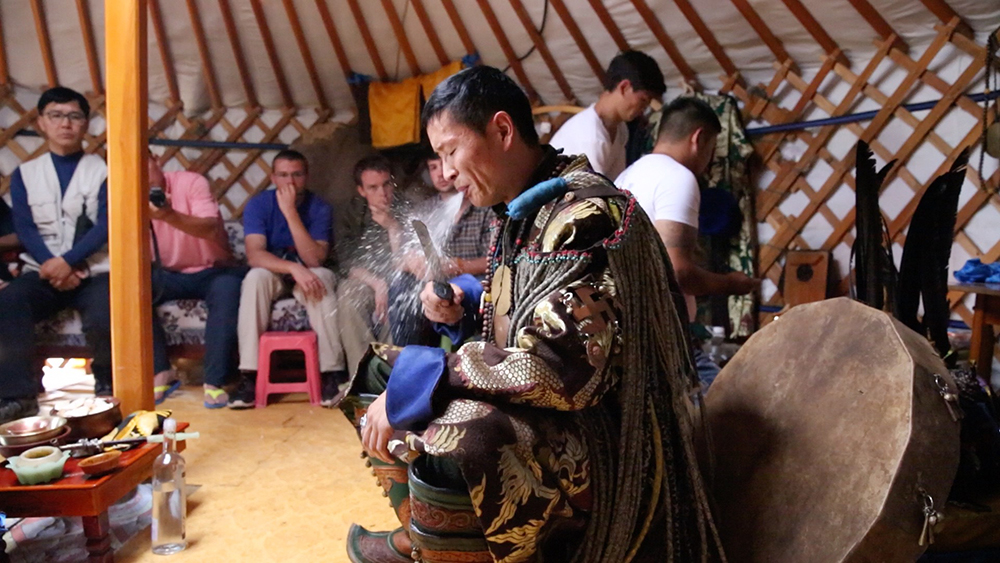We crouched on stools for four hours, watching each move the Mongolian shaman made. Somehow all 30 of us — 10 Americans, 14 Koreans, 2 Mongolian guides, the shaman and his assistants — all fit comfortably in his ger, a Mongolian version of a round yurt with felt sides. The guides arranged for us to attend the shaman’s ceremony that day, and it seemed obvious on both sides that no one knew what to expect. It was our first time seeing a shaman and his first time performing in front of travelers outside of his village.
I was 10 days into a two-week excursion through Mongolia with a group of University of Georgia Honors Program students, led by a UGA professor who specializes in Buddhism and accompanied by 14 of her friends and fellow professors from South Korea. During the trip, we bumped over unpaved roads from the capital, Ulaanbataar, to the most remote areas of the country and back again. Along the way, we touched reindeer, held hawks on our arms, rode horses like the nomads who still herd livestock across the Mongolian plains, and camped at one of the world’s largest freshwater lakes. For many of us, the highlight of the trip was back near the capital, where our guides led us to the shaman’s village to meet a friend of a friend, as connections often go in Mongolia. Now, 30 of us sat in a semicircle inside his ger, waiting as the shaman and his assistants prepared for the ceremony.
As we tried cups of warm mare’s milk and nibbled on cheese, I glanced around the ger to imagine what would happen next. Across from the door, three outfits and three headdresses hung on the wall. The shaman and his two brothers, who were also shamans, wore different outfits and summoned different spirits, our Mongolian guide explained. To the left of the outfits, an offering table with candles and carvings of animals sat at shin height, which welcomed the spirits into the ger before one moved into the shaman’s body. I looked closer and saw the shaman’s main assistant — his mother — dipping objects into a small bowl of liquid to cleanse them for the ceremony. The bottle she poured it from was unmistakable: Vodka.
“Spirits for the spirits,” said our professor, who sat on the stool next to me.
 The shaman’s mother assists in purifying ceremonial objects in vodka. All photos courtesy of Carolyn Crist.
The shaman’s mother assists in purifying ceremonial objects in vodka. All photos courtesy of Carolyn Crist.
I watched as the shaman’s mother carefully dipped everything that would be used in the ceremony into the small bowl — beaded necklaces, the carvings, the shaman’s pipe and his staff. She even rubbed vodka onto the plastic pieces embedded into his outfit and headdress. As she prepared the objects, the shaman sat in front of us on his own stool, calmly answering our questions about shamanism. According to tradition, ancestral spirits choose who should be a shaman and after a series of signs, typically a severe illness, a person can decide whether to accept the lifestyle. If so, he or she trains how to prepare offerings correctly, induce a trance, and act as a vessel for an ancestral spirit to enter the body. Our shaman accepted the duty four years ago and calls his great-grandfather’s spirit into his body during each ceremony.
Nearby, the shaman’s friend fired up a portable blowtorch to heat up the blade of a dull knife. The shaman poured himself a shot of vodka, gulped it and took the knife. He spewed the vodka on both sides and licked the knife repeatedly with a shocking movement, as if burning the taste buds off his tongue. The air seemed to sizzle each time his tongue hit the blade. The preparation was complete.
The shaman stepped out of the ger for a moment before the ceremony began, and our guides talked about the foundation of shamanism, which started in the Mongolian grasslands before Buddhism crossed into the country from Tibet in the 16th century. Based on the worship of nature, particularly the sky, mountains and rivers still so apparent in the landscape, the practice focuses on rituals that please the spirits of ancestors who once raised livestock on the same pastures.
Banned for 70 years under the forced atheism of the Soviet Union, shamanism is now reblossoming in Mongolia with the sense of a nation reinventing its history. Shamans died in labor camps during Soviet rule, as did Buddhist monks who fled to the mountains. The landlocked country remains politically and economically tied to its neighbors, Russia and China, which both marginalized and oppressed the Mongolian people throughout history. Now residents are turning to shamans both for the mysticism of an ancient practice and to seek advice from a familiar villager, along with a rekindled sense of shared culture.
Vodka — often seen as a Russian staple — seems an odd choice for those reclaiming religious freedom and purifying objects before a ceremony. At the same time, it breaks stereotypes and reclaims identity. Traditionally, shaman ceremonies used liquor distilled from fermented milk to purify objects. Mare’s milk is still a popular alcoholic drink in Mongolia, often sold by herders on rocky roadsides in recycled soda bottles and milk jugs. It has a potent earthy smell and sour taste, almost like a sour beer. Originally, this vodka-like milky drink was considered the most powerful liquor because it contained the essence of the herds. Today, many shamans opt for the finished product of vodka (cheaper, more convenient and frequently given as an offering by visitors) to purify items, but still believe in the healing and purifying powers that honor nature and livestock.
 The shaman spits vodka onto his knife to purify it for the ceremony.
The shaman spits vodka onto his knife to purify it for the ceremony.
In the final moments before transformation, the shaman’s mother poured a shot of vodka into a small bowl for him to drink. Seated on a plastic stool like ours, the shaman faced the offering table, put on his headdress and grabbed a large drum covered with animal skin. He began beating the drum and humming, swaying side to side to the rhythm for several minutes to induce a trance. The drumming grew louder as he beat harder. His mother motioned for me and a fellow traveler to step back, just moments before the shaman burst from the stool, spinning around in circles and nearly hitting us with the drum. He fell to the floor, shaking and grumbling in a low, gravelly voice. According to shamanic tradition, the spirit of his great-grandfather had been summoned into his body.
As he settled into a seated position, the shaman’s mother carried over a tray of items to be used during the ceremony, including a long pipe, a bag with tobacco, a bottle of vodka and the same small bowl used to purify his outfit. She poured a shot and handed it to him. He rose the bowl to his chin, allowing some of the thin black tassels that covered his face like a veil to dip into the drink.
He called forward the first guest of the ceremony, who knelt on a carpet square in front of the seated shaman and leaned forward, nearly placing his head in the shaman’s lap. The man asked for advice about his upcoming marriage and his struggling business. The shaman grumbled words that we could not hear or understand and then shook a staff over the man’s back to offer a blessing. Of course, he cleansed it with vodka.
As each person approached and knelt, the shaman took another shot to satiate the spirit. When he spoke with two of our travelers — one guy and one gal — he created a talisman for them by ripping objects from his outfit and putting them on a string. He placed a necklace over the guy’s head and a bracelet on the gal’s arm. He dipped those in vodka, too.
As the four hours came to a close, the shaman motioned for one of our guides to come forward and translate. He welcomed our group to Mongolia, hoped we enjoyed the country and said there was much more to explore in the historical land. He encouraged us to chant a blessing along with him before the spirit left his body and the ceremony was complete. The shaman waved the staff and moved his arms in circles — and then sealed it with a shot of vodka.





